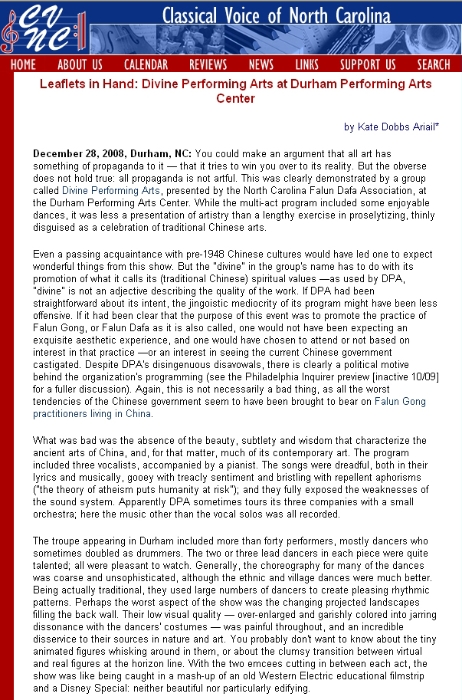December 28, 2008, Durham, NC: You could make an argument that all art has something of propaganda to it — that it tries to win you over to its reality. But the obverse does not hold true: all propaganda is not artful. This was clearly demonstrated by a group called Divine Performing Arts, presented by the North Carolina Falun Dafa Association, at the Durham Performing Arts Center. While the multi-act program included some enjoyable dances, it was less a presentation of artistry than a lengthy exercise in proselytizing, thinly disguised as a celebration of traditional Chinese arts.
Even a passing with pre-1948 Chinese cultures would have led one to expect wonderful things from this show. But the "divine" in the group's name has to do with its promotion of what it calls its (traditional Chinese) spiritual values —as used by DPA, "divine" is not an adjective describing the quality of the work. If DPA had been straightforward about its intent, the jingoistic mediocrity of its program might have been less offensive. If it had been clear that the purpose of this event was to promote the practice of Falun Gong, or Falun Dafa as it is also called, one would not have been expecting an exquisite aesthetic experience, and one would have chosen to attend or not based on interest in that practice —or an interest in seeing the current Chinese government castigated. Despite DPA's disingenuous disavowals, there is clearly a political motive behind the organization's programming (see the Philadelphia Inquirer preview [inactive 10/09] for a fuller discussion). Again, this is not necessarily a bad thing, as all the worst tendencies of the Chinese government seem to have been brought to bear on Falun Gong practitioners living in China.
What was bad was the absence of the beauty, subtlety and wisdom that characterize the ancient arts of China, and, for that matter, much of its contemporary art. The program included three vocalists, accompanied by a pianist. The songs were dreadful, both in their lyrics and musically, gooey with treacly sentiment and bristling with repellent aphorisms ("the theory of atheism puts humanity at risk"); and they fully exposed the weaknesses of the sound system. Apparently DPA sometimes tours its three companies with a small orchestra; here the music other than the vocal solos was all recorded.
The troupe appearing in Durham included more than forty performers, mostly dancers who sometimes doubled as drummers. The two or three lead dancers in each piece were quite talented; all were pleasant to watch. Generally, the choreography for many of the dances was coarse and unsophisticated, although the ethnic and village dances were much better. Being actually traditional, they used large numbers of dancers to create pleasing rhythmic patterns. Perhaps the worst aspect of the show was the changing projected landscapes filling the back wall. Their low visual quality — over-enlarged and garishly colored into jarring dissonance with the dancers' costumes — was painful throughout, and an incredible disservice to their sources in nature and art. You probably don't want to know about the tiny animated figures whisking around in them, or about the clumsy transition between virtual and real figures at the horizon line. With the two emcees cutting in between each act, the show was like being caught in a mash-up of an old Western Electric educational filmstrip and a Disney Special: neither beautiful nor particularly edifying.
For other reviews of DPA, see http://www.guardian.co.uk/stage/2008/feb/25/dance
http://www.thestar.com/entertainment/article/295651
And for comments from the other side, see http://www.china-embassy.org/eng/gyzg/t397390.htm
(Classical Voice of North Carolina, December 28, 2008)

Original text from: http://www.cvnc.org/reviews/2008/122008/DPA.html





